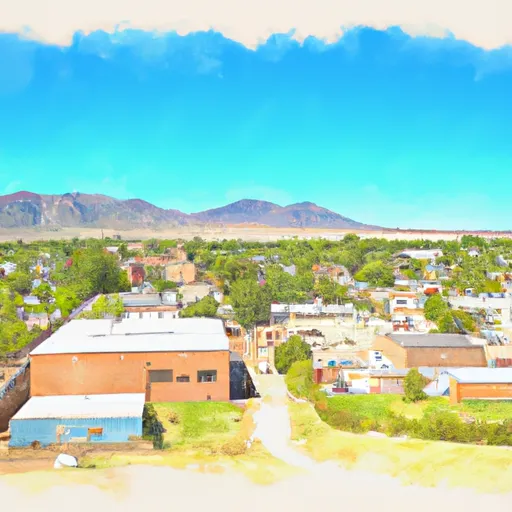-
 Snoflo Premium
Snoflo Premium
Get unlimited access to all our content
With no Ad interruptions! - Start Your Free Trial Login with existing account
Talmage
Eden Index
Climate
6.9
•
Recreation
5.1
•
Community
•
Safeguard
4.5/10

Talmage is a small town nestled in the Uinta Basin of northeastern Utah. The climate in Talmage is classified as semi-arid, with hot summers and cold winters. Average high temperatures in the summer can reach the 90s°F (30s°C), while winter temperatures often drop below freezing, with occasional snowfall.
Hydrologically, Talmage is situated near the Ashley Creek, a tributary of the Green River. The creek provides a vital water source for the surrounding agriculture, supporting fields of alfalfa, hay, and livestock grazing. Additionally, Talmage benefits from the presence of several natural ponds and reservoirs, offering recreational opportunities such as fishing and boating.
Nature enthusiasts can explore the beautiful surrounding landscapes of Talmage. The nearby Uinta Mountains provide ample opportunities for outdoor recreation, including hiking, camping, and wildlife watching. The Ashley National Forest, with its vast expanse of forested areas, offers scenic trails for hiking and mountain biking. Additionally, the area is known for its excellent hunting opportunities, attracting hunters from across the state.
In summary, Talmage, Utah, offers a semi-arid climate with hot summers and cold winters. Hydrologically, it benefits from the Ashley Creek and various ponds and reservoirs. Outdoor enthusiasts can enjoy activities such as fishing, boating, hiking, camping, wildlife watching, and hunting in the nearby Uinta Mountains and Ashley National Forest.
What is the Eden Index?
The Snoflo Eden Index serves as a comprehensive rating system for regions, evaluating their desirability through a holistic assessment of climate health, outdoor recreation opportunities, and natural disaster risk, acknowledging the profound impact of these factors on livability and well-being.
Climate Health Indicator (CHI): 6.9
Talmage receives approximately
325mm of rain per year,
with humidity levels near 69%
and air temperatures averaging around
6°C.
Talmage has a plant hardyness factor of
5, meaning
plants and agriculture in this region thrive during a short period during spring and early summer. Most
plants will die off during the colder winter months.
By considering the ideal temperature range, reliable water supplies, clean air, and stable seasonal rain or snowpacks, the Climate Health Indicator (CHI) underscores the significance of a healthy climate as the foundation for quality living.
A healthy climate is paramount for ensuring a high quality of life and livability in a region, fostering both physical well-being and environmental harmony. This can be characterized by ideal temperatures, reliable access to water supplies, clean air, and consistent seasonal rain or snowpacks.
Weather Forecast
Streamflow Conditions
Lower Green
Area Rivers
Lower Green
Snowpack Depths
Lower Green
Reservoir Storage Capacity
Lower Green
Groundwater Levels
Recreational Opportunity Index (ROI): 5.1
The Recreational Opportunity Index (ROI) recognizes the value of outdoor recreational options, such as parks, hiking trails, camping sites, and fishing spots, while acknowledging that climate plays a pivotal role in ensuring the comfort and consistency of these experiences.
Access to outdoor recreational opportunities, encompassing activities such as parks, hiking, camping, and fishing, is crucial for overall well-being, and the climate plays a pivotal role in enabling and enhancing these experiences, ensuring that individuals can engage in nature-based activities comfortably and consistently.
Camping Areas
| Campground | Campsites | Reservations | Toilets | Showers | Elevation |
|---|---|---|---|---|---|
| Bridger Lake | 30 | 9,355 ft | |||
| Marsh Lake | 46 | 9,365 ft | |||
| Reservoir | 5 | 7,922 ft | |||
| Moon Lake | 55 | 8,198 ft | |||
| Miners Gulch | 5 | 7,478 ft | |||
| Swift Creek | 13 | 8,136 ft | |||
| Yellowstone | 11 | 7,634 ft | |||
| China Meadows | 9 | 9,392 ft | |||
| Starvation State Park | 54 | 5,762 ft | |||
| Little Lyman Lake | 10 | 9,287 ft |
Nearby Ski Areas
Catastrophe Safeguard Index (CSI):
The Catastrophe Safeguard Index (CSI) recognizes that natural disaster risk, encompassing floods, fires, hurricanes, and tornadoes, can drastically affect safety and the overall appeal of an area.
The level of natural disaster risk in a region significantly affects safety and the overall livability, with climate change amplifying these risks by potentially increasing the frequency and intensity of events like floods, fires, hurricanes, and tornadoes, thereby posing substantial challenges to community resilience and well-being.
Community Resilience Indicator (CRI):
The Community Resilience Indicator (CRI) recognizes that education, healthcare, and socioeconomics are crucial to the well-being of a region. The CRI acknowledges the profound impact of these elements on residents' overall quality of life. By evaluating educational resources, healthcare accessibility, and economic inclusivity, the index captures the essential aspects that contribute to a thriving community, fostering resident satisfaction, equity, and social cohesion.

